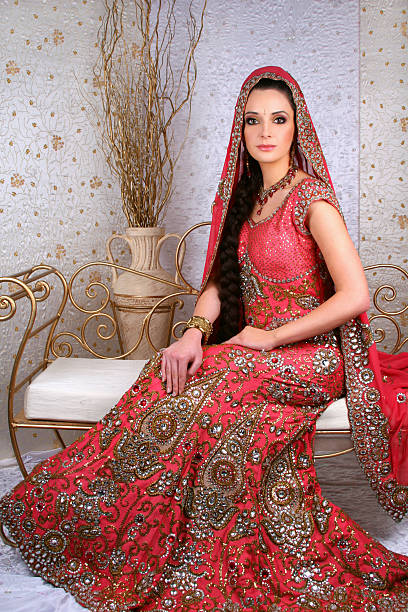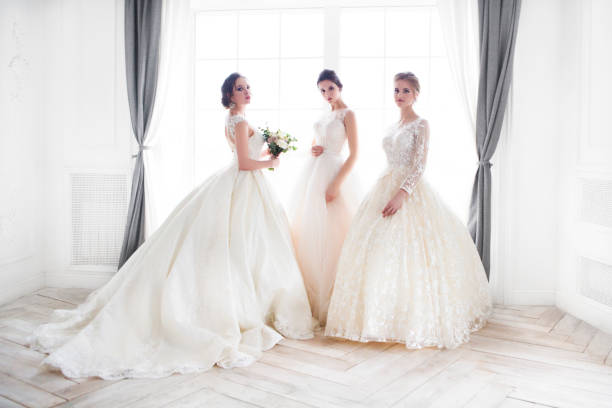The story of the wedding dress is much shorter than wedding ceremony history and is even less than the history of marriage.
The story of the wedding dress is much shorter than that of marriages and is even less than the wedding’s history. A long-time Chinese myth is one of the earliest known mentions of a wedding dress that goes like this:
There was a time when in a lush and misty land at the heart of the universe there was a shrewd dog that was also dragon. Naturally, he wasn’t married. The dragon-dog called Panhu was a service of the emperor, who was fighting a rebellious general. The emperor declared that any person who could deliver him the head of his adversaries was to be granted an engagement ring from his wife during marriage.
Panhu did not look like a human being, but being a loyal and courageous man, he vowed to become one after defeating the enemy to be married by the Princess. Panhu succeeded, transformed into a human, and got married to the daughter of the Emperor. To ensure that the marriage was a happy one the empress dressed her in a gorgeous phoenix gown and phoenix crown. Panhu took his bride away to the mountains of southern. They were content and had a number of children. When it was time for their daughter to get married an actual phoenix soared from the mountains and presented their bride with a vibrant phoenix outfit completely her own.
Weekly Digest
Today, whether we’re speaking of the lavish white gowns that are featured within Western bridal publications or elegant red phoenix dress with mythical origins that are still worn by brides from China these days the wedding dress has evolved into its own magical talisman. The focus is on the color which is why white is the most popular choice for brides who are from the West and all the way from Norway to Argentina as well as red being the most appropriate hue for more wedding dresses traditionally worn by Eastern brides, regardless of whether they’re of South Sudan or Singapore. We assign significance to these colors in the belief that white should be a symbol of purity and new beginnings, whereas red may just be a symbol for luck, life and joy. However, this hasn’t all the time and the wedding gowns we call “traditional” are, for the most part, quite contemporary, regardless of the country from which they originate.
As opposed to ospreys, swans coyotes and termites The primates called Homo sapiens don’t typically have a relationship for the rest of their lives. While naked apes might find a partner who they will remain with all the time, never moving but history has proven that this hasn’t been the norm for us. However, marriage, which is an instrument of socialization is a phenomenon that has emerged in a variety of societies and on every continent.
In the vast majority of its time, marriage has been a societal issue, dealing to the exchange of properties, birth and care for children as well as the monitoring of bloodlines, as well as the control of women. Because of these, it was generally a woman-man affair, irrespective of society’s views on homosexuality. Although there have been weddings throughout the entirety of the history of mankind, it doesn’t mean there were no ceremonies for weddings. For instance, there are wedding ceremonies that do not involve the exchange of vows found from the Bible. Weddings were legally recognized through the signing of a contract, or another legal agreement, but weddings were not typically considered to be a religious or even a romantic event. Also, since the weddings were not held for a long period, there were no real wedding gowns also.
While the people of ancient Sumer, Babylon, and Assyria were awed by romantic and erotic romance in poetry and art but the issue of marriage was much more transient. The Herodotus Histories relate the Babylonian wedding market which was held every year, in which young brides were presented before a crowd people who bid for the girls, much as slaves, based on their beauty. These women who were “most beautiful” were chosen as wives for the affluent and those who were the “ugliest” women who did not sell were sold to the common people, along with reimbursement for their expenses as farm animals that were a problem.
It is possible to conclude that Babylon’s wedding market were required to be attractive and market-ready, so that they could fetch the most expensive price (as well as, it is likely being sold in the most comfortable conditions). Herodotus isn’t clear on the clothes these women were wearing, but it is likely that someone was trying to make sure they were dressed to impress with a gleaming apple to display on the cart of apples.
In 1875, the British artist Edwin Long painted an interpretation of the scene drawing inspiration from Herodotus’s account and also images taken from Assyrian artifacts. All brides-to-be in Long’s painting wear laced clothes in white or cream and the men who are bidding on their brides are dressed in a mix of darker shades. However, this colour scheme has more in common with Victorian concepts of virgins, weddings and purity — concepts that almost definitely were not prevalent in the past, and has no actual historical precedent. However, at specific occasions and in certain areas certain ideas regarding the type and beauty a bride-to-be should have were snagged from a tale or myth, part of the culture or a well-known wedding and the ensuing traditions and superstitions have led to. As time passes, these occurrences have been incorporated into ceremonies.
In most times in the past, even Western brides were not wearing white. In the era of ancient Rome where weddings were held with banquets and parties – an important social event, but not a sacrament. Brides had long veils that were deep yellow, layered over a complex braided hairstyle with six parts. The veil of yellow was described as “the color of flame,” which is why the brides themselves were torchlights, bringing the light and warmth to their husbands home.
Ancient Athenian brides were dressed in long, light reddish or violet gowns, which were cinched around the waist with a girdle, which groomsmen were supposed to loosen later, a symbol of the loss of virginity. The wedding was officially celebrated by a celebration that was followed by an illuminated torch procession that took couples to the wedding chamber. When they arrived, the Athenian bride was presented with an apple to eat into, a la Persephone taking a bite of the pomegranate seeds from the orchards of the underworld that connected her to her newly-wed partner, Hades.
The main theme in wedding ceremonies is the symbolic transition of childhood into adulthood and from one particular age to the following. This is particularly relevant for women who transition through the sexy girlhood, the springtime stage into the mature, fruitful phase of marriage, in which they’ll be expected to have children. In a variety of cultures rituals which encapsulates young women in the world of sexuality and motherhood is portrayed as a sort of funeral of the old woman and is accompanied by ritualized mourning and formal mourning. In some instances, the clothes that brides wear reflect these themes.
China could be the first country where brides were expected to dress in the same colour. Under the rule of the Zhou Dynasty some three thousand years back, brides and grooms were both dressed in black dress robes, with red trim with a white undergarment. The use of certain colours and patterns wasn’t just reserved for weddings. Zhou rulers enacted strict dress rules that defined what was acceptable to be and by whom and what time, based on the profession, social class gender, occasion, and social caste. These laws were in place at the time in the Han Dynasty, around 200 B.C., when brides and groomsmen dressed in black. The Hans were reputedly less strict with respect to dress rules, but they nevertheless required that certain colors were used at specific seasons such as the color of spring is green, red in the summer, yellow in the autumn and black in winter.
In the 7th century, under the rule of the Tang Dynasty, with clothing restrictions further relaxed the fashion wedding brides would wear a green dress to their weddings – perhaps in an allusion to the springtime attire of the preceding Han period. Their grooms usually were wearing red. A more relaxed social system resulted in more diverse and experimental styles, with women sporting short dresses and even traditional male clothing in their everyday life. In the Tang Dynasty ruled during a period of great migration and influence from culture that travelled through China into the two regions of Japan along with the Korean peninsula. The fashions of that Tang period can be seen in a few classic Japanese as well as Korean bridal gowns of present day, both in the color as well as in their form.
In Japan weddings, the bride usually wears a variety of kimonos in various colors during her wedding ceremony. The typical Japanese Shinto bride wears white. Since the 14th century, Korean silk wedding robes included green, red and yellow. Similar to Zhou Han-ruled China and China, traditional Korean styles were also controlled by the color. Adults and children who were not married during Imperial Korea wore bright hues when they were married, while after the women and the men during this time both carried white or neutrals until the time they reached old age. The elderly were dressed in white only, which was a color used for mourning. All people were obligatory to dress in white during the a period of three years following the death of the emperor or family member.
Traditions Korean brides had to represent the same theme that is prevalent in wedding gowns across the world and emulate the look of royals. It is also, in a way the reason why Western brides started to wear white dresses as well and the way a specific type that was traditional white Western wedding dress started to take over weddings around the entire world.
A dress for a first wedding in Europe and other European-dominated countries is usually white by default. However, brides who are married in a different color can do in a way that is a departure from. However, the widespread use of this fashion is recent, and it became the norm in the middle of the nineteenth century when the Queen Victoria was married to Prince Albert on the 18th of April in 1840. Prior to that, while brides could wear white as long as they had the money however, the most wealthy and most royal of them also wore gold or blue or if not wealthy or royal no matter what color their ideal gown happened to be.
The first recorded example of a wedding in a white dress in Western culture is Philippa, the English Princess Philippa when she was married to Scandinavian Eric, the King of Scandinavia. Eric around 1406. The dress she wore was an elegant white dress trimmed with squirrel fur and ermine. in 1558 Mary the Queen of Scots was a white bride to the king-to-be of France, even though white was the color used to mourn for French queens of the time. In the following centuries, white was an extremely popular, but it was not an absolute requirement to be used for weddings of royals (Princess Charlotte, when she was married to Prince Leopold of Saxe-Coburg Saalfeld in 1816, was wearing an empire-waisted dress made of silver). White gowns did not represent purity or even virginity however, they were more expensive and more difficult to maintain and communicated the worth and status that the person wearing it.
From the mid-point of the 19th century, women, even royalty, could wear a wedding dress once, and never again. An idea that would have seemed absurd even for the extremely wealthy prior to that time of industrialization. Even the queen Victoria used her own wedding gown and veil for future use. If a woman who was not royalty did wear a gown specially designed for the occasion the dress was likely to be her new Sunday dress whether it was in its original form or in a dyed or altered state, until the time she took it off or the style changed beyond the limits of alteration. Most of the time the bride was wedding-ready in the most elegant gown she had.
The entire scenario would alter for Western brides following the marriage of queen Victoria as well as the Industrial Revolution, due to a few technological advancements, including photography and the advent illustration magazines.
Numerous Chinese brides take part in a lavish wedding photo shoot wearing an Western white gown.
When the Queen Victoria got married to her cousin Albert who was her cousin Albert, the German prince of Saxe Coburg-Gotha she wore a lavish pale gown adorned with flowers of orange that was made in the fashion of the time–a slender bodice that embraced the natural waistline and a full long skirt, which was that was slung over the body by crinolines and petticoats. Although often described as white and painted in photographs, the dress is actually in the Royal Collection (minus its lace overlay) is actually something more of an ivory or perhaps a light pink–champagne the dress could be described in a contemporary bridal catalog. Instead of a jewel-encrusted crown, the royal youngster was adorned with an orange blossom wreath–a higher-end model of the kind a country girl would wear for her wedding–and this further attracted the queen’s new clients.
In fact it is true that the British people adored the love story of Victoria and her prince charming and thought they represent a perfect example of domestic bliss that women of the day wanted to imitate her wedding dress in every way they could. There aren’t any photographs of the queen Victoria or Prince Albert at their wedding. However, there are court pictures that were taken 14 years later in 1854 which was taken when the couple were in their late 30s, is often misinterpreted as wedding pictures since the queen is dressed in an ethereal dress as well as a veil and a crown of flowers. However, images of the queen’s wedding day were widely circulated.
The increase in photography, and wedding portraits specifically was also a significant way in promoting the white wedding-dress trend. Beyond being the preferred choice of an affluent queen white dresses were stylish as they stood out from sometimes messy black-and white or sepia-toned photographs. They were distinct and made for the perfect backdrop to highlight your bride’s beauty.
In 1849, women’s magazines were already announcing that white was not only the most appropriate color for wedding dresses and that it was always been the ideal and the most appropriate option. In a little bit of a revisionist past, the Godey’s Lady’s Book announced that “[c]ustom has determined, since the very beginning to choose white as the most appropriate color for brides regardless of the fabric. It’s an ode to the innocence and purity of childhood, as well as her heart, which is unadorned, is willing to give to the one she has chosen.” Victorian ideals of weddings, romantic love and pureness were projected backwards to redefine the white gown as a symbol of purity and purity rather than the wealth.
The fashion trend was embraced and Queen Victoria’s 1840s-style wedding dress — the slim waist as well as the lace, and the full skirt of the nineteenth century with petticoats and croinolines –is thought of as the most well-known “wedding” silhouette. It’s now regarded as to be the “classic” wedding dress across the globe. While the design was very much in line with the other dresses that Queen Victoria had worn in the past, reflecting the prevailing fashions of the time Its uniqueness is one of the reasons that make the idea the idea of wedding dresses distinctive. For many brides it’s the only occasion they wear a dress similar to that which is a dress in the fashion of the 19th century. A lot of Chinese brides participate in a glitzy wedding photo shoot in an Western white dress. Sometimes, they even travel across the world for a trip to Paris as well as New York for the sole reason of taking photos, even when she decides to wear the traditional Chinese outfit to her wedding ceremony.
Traditional African tribal wedding dress can be seen throughout the continent. The Ndebele people from South Africa, renown for the distinctive ring-shaped jewelry that is used to lengthen the neck, wear bridesmaids’ dresses in a beads dress known as Nyoga. Nyoga that hangs from shoulders to the ground, being dragged behind in the snake-like, sinuous motion. ( Nyoga in actually is a reference to snakes.) In urban areas, as well as some pastoral ones, like the Fransfontein region in Namibia It is becoming increasingly typical that weddings are planned according to a Western fashion, with an extravagant white dress and the groom dressed in an elegant tuxedo, a rental expensive vehicle as well as the bridesmaids and groomsmen wearing matching outfits. As in most of the in the globe, ceremonies are now an event that is a focus for attention-grabbing consumption. The bride is not only expected to wear a gown that she’ll ever wear but but so do the guests in the bridal party – essentially, a queen’s lady in waiting.



